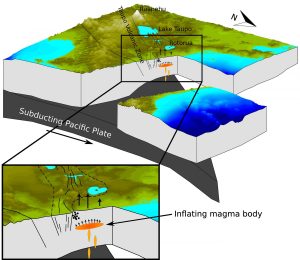
Scientists say they’ve discovered a magma buildup near a New Zealand town that explains a spate of recent earthquakes and could signal the beginnings of a new volcano—although they’re not expecting an eruption anytime soon.
Geophysicist Ian Hamling said that since 1950, enough magma to fill 80,000 Olympic-size swimming pools has squeezed up beneath the surface near the coastal town of Matata, about 200 kilometers (120 miles) southeast of Auckland.
A paper published Saturday in the online journal Science Advances outlines the findings. Hamling, the paper’s lead author, said that while other parts of New Zealand have active volcanoes, there have been none near Matata for at least 400,000 years.
“It was quite a big surprise,” he said in an interview with The Associated Press.
Using GPS data and satellite images, the scientists say they discovered an area of land about 400 square kilometers (154 square miles) has risen by 40 centimeters (16 inches) since 1950.
Hamling said a period of quick uplift between 2004 and 2011 likely triggered thousands of small earthquakes. Scientists had previously thought tectonic shifts caused the quakes.
Hamling said the magma remained about 10 kilometers (6 miles) below the surface, deep enough that he didn’t expect a volcano to develop within his lifetime. He said a volcano could develop over hundreds or thousands of years, or the magma could eventually cool and harden.
Matata is home to about 650 people. Hamling said he hoped further study would allow scientists to develop a warning system for earthquakes in the area. He said the quakes are likely triggered by magma stressing and breaking rock.
Hamling said it was unusual worldwide to discover magma buildup in an area with no volcanoes. He said modern equipment allowed them to accurately measure tiny horizontal and vertical changes in the coastal land.
Just over half of the area studied is offshore, however, and Hamling said the scientists needed to rely on inferences from what happened on the land to gauge the changes underwater.
Victoria Miller, a volcanologist with Geoscience Australia who was not involved in the research, said the location was of interest because it was outside of an active volcanic area.
“The scientific analysis seems robust and notes the limitations of modelling an offshore source,” Miller wrote in an email.
Reference:
I. J. Hamling et al. Off-axis magmatism along a subaerial back-arc rift: Observations from the Taupo Volcanic Zone, New Zealand, Science Advances (2016). DOI: 10.1126/sciadv.1600288
Note: The above post is reprinted from materials provided by The Associated Press.









